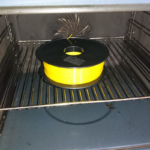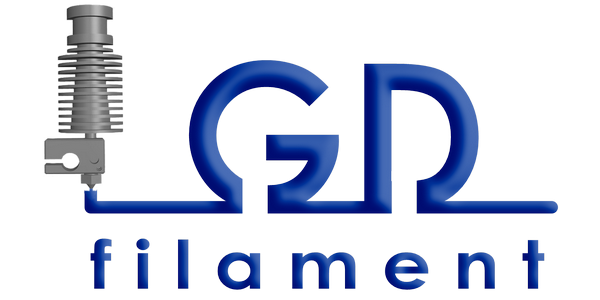Residual Moisture is one of the main enemies of good and quality 3D printing. All filaments are hygroscopic – they have a tendency to absorb and retain moisture from the environment. The higher the humidity in the environment, the more likely it is that your filament will have a higher water content.
 We control the temperature and humidity of the rooms where we store the finished and vacuumed filament. We use ordinary air-dryers and clima devices. Unfortunately, it`s not possible to do this in the process of extruding the thread itself until the roll is vacuumed. There is some residual moisture in the vacuumed filament, despite the presence of a desiccator (dehumidifier – silica gel or other agent), which we put in vacuum packs. To make a solid thread we use water to cool the extruded filament. After opening the package for use of the filament, it immediately begins to absorb moisture from the environment. The effect of this moisture is the presence of stringing (threads) or bubbles (bubbles) or wraps (peeling of layers). So this significantly impairs the quality of the 3D printed model, and may even can make it unusable.
We control the temperature and humidity of the rooms where we store the finished and vacuumed filament. We use ordinary air-dryers and clima devices. Unfortunately, it`s not possible to do this in the process of extruding the thread itself until the roll is vacuumed. There is some residual moisture in the vacuumed filament, despite the presence of a desiccator (dehumidifier – silica gel or other agent), which we put in vacuum packs. To make a solid thread we use water to cool the extruded filament. After opening the package for use of the filament, it immediately begins to absorb moisture from the environment. The effect of this moisture is the presence of stringing (threads) or bubbles (bubbles) or wraps (peeling of layers). So this significantly impairs the quality of the 3D printed model, and may even can make it unusable.
WHAT SHOULD WE DO TO AVOID THIS?
We recommend to dry the filaments before using them. Bellow we show the recommended drying temperatures for the different types of filaments:
PLA / PVA 50 ° ≥4 hours
PP / FLEX (TPU) 55 ° ≥4 hours
ABS / ASA 60 ° ≥4 hours
PETG 65 ° ≥3 hours
PC / PC-ABS / PA (nylon) 70 ° ≥8 hours
You can use the following dryers (I have no intention of advertising a manufacturer – I have used sample images available on the Internet to illustrate):
1. Ordinary home oven
 A ordinary home oven is suitable to dry filaments. Just place the filament inside and set the temperature. Use immediately after drying or place in a plastic bag with a desiccator. We usually dry the filaments at night.
A ordinary home oven is suitable to dry filaments. Just place the filament inside and set the temperature. Use immediately after drying or place in a plastic bag with a desiccator. We usually dry the filaments at night.
2. Specialized devices
 They are specialized filament dryers on the market. The price varies and most of them are suitable for drying filament while printing. The filament is placed in the device and from there it is fed directly to the extruder of the 3D printer. Most of these appliances don`t have a built-in fan to remove moisture from the appliance.
They are specialized filament dryers on the market. The price varies and most of them are suitable for drying filament while printing. The filament is placed in the device and from there it is fed directly to the extruder of the 3D printer. Most of these appliances don`t have a built-in fan to remove moisture from the appliance.
3. Other appliances
 We dry the filaments before printing in fruit dryers. Simply remove some of the horizontal dividers to make larger space (enough to hold one roll). Leaving the filament in such an appliance for 6-8 hours is absolutely enough for its good drying. Storage with desiccator (silica gel) is mandatory after that.
We dry the filaments before printing in fruit dryers. Simply remove some of the horizontal dividers to make larger space (enough to hold one roll). Leaving the filament in such an appliance for 6-8 hours is absolutely enough for its good drying. Storage with desiccator (silica gel) is mandatory after that.
4. Reactivation of the desiccator (silica gel)
 The bags with desiccator (silica gel, dehumidifier) that we put in the vacuum packages absorb some of the moisture of the filament after it is vacuumed. This silica gel can absorb up to 40% of its weight in moisture. After a certain period the silica gel is saturated and needs to be reactivated. This reactivation removes the moisture and so the bags can be used again. This can be done in a simple household oven by simply placing the dehumidifier bags at 100 ° ≥1 hour. You can place the bag on baking paper or aluminum foil. It is a good idea to store spare bags in a vacuum pack or container.
The bags with desiccator (silica gel, dehumidifier) that we put in the vacuum packages absorb some of the moisture of the filament after it is vacuumed. This silica gel can absorb up to 40% of its weight in moisture. After a certain period the silica gel is saturated and needs to be reactivated. This reactivation removes the moisture and so the bags can be used again. This can be done in a simple household oven by simply placing the dehumidifier bags at 100 ° ≥1 hour. You can place the bag on baking paper or aluminum foil. It is a good idea to store spare bags in a vacuum pack or container.
The normal humidity for a comfortable lifestyle is between 40% and 60%. The recommended humidity in the room where you store the filaments should not exceed 40-45%. We maintain humidity in our premises below 40%. If your humidity is higher, you can also use dehumidifiers (also dehumidifiers) – also available on the market or if you have air conditioning – you can turn it on to dry the air.
